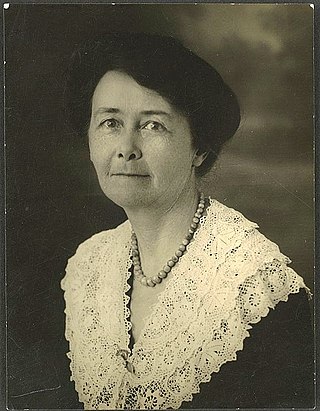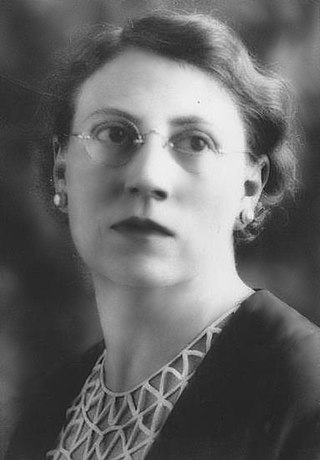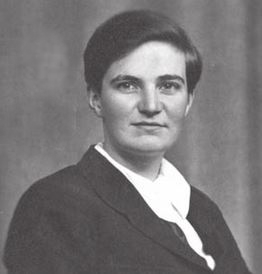
Edward Vivian "Vance" Palmer was an Australian novelist, dramatist, essayist and critic.

Janet Gertrude "Nettie" Palmer was an Australian poet, essayist and Australia's leading literary critic of her day. She corresponded with women writers and collated the Centenary Gift Book which gathered together writing by Victorian women.

Stella Maria Sarah Miles Franklin, known as Miles Franklin, was an Australian writer and feminist who is best known for her novel My Brilliant Career, published by Blackwoods of Edinburgh in 1901. While she wrote throughout her life, her other major literary success, All That Swagger, was not published until 1936.
The Division of Eden-Monaro is an Australian electoral division in the state of New South Wales.

Cinesound Productions Pty Ltd was an Australian feature film production company. Established in June 1931, Cinesound developed out of a group of companies centred on Greater Union Theatres that covered all facets of the film process, from production to distribution and exhibition.

Percival Serle was an Australian biographer and bibliographer.
The Australian Literature Society Gold Medal is awarded annually by the Association for the Study of Australian Literature for "an outstanding literary work in the preceding calendar year." From 1928 to 1974 it was awarded by the Australian Literature Society, then from 1983 by the Association for the Study of Australian Literature, when the two organisations were merged.

Marjorie Faith Barnard was an Australian novelist and short story writer, critic, historian—and librarian. She went to school and university in Sydney, and then trained as a librarian. She was employed as a librarian for two periods in her life, but her main passion was writing.
The Holden Dealer Racing Team was an Australian motor racing team, covertly backed by General Motors-Holden's through their dealer network so as to get around GM's worldwide ban on the company being involved in motorsport. The HDRT contested the 1968 Hardie-Ferodo 500 endurance race at the Mount Panorama Circuit, Bathurst, as well as the 1968 London-Sydney Marathon using GMH's latest car, the Holden HK Monaro.
Albert John "Harrison" Owen was an Australian playwright, novelist, poet, and journalist.
This article presents a list of the historical events and publications of Australian literature during 1885.
The Madeleine Heritage (1928) is a novel by Australian author Martin Boyd. It won the ALS Gold Medal in 1928.
The Passage (1930) is a novel by Australian author Vance Palmer. It won the ALS Gold Medal for Best Novel in 1930.
Up the Country : A Tale of Early Australian Squattocracy (1928) is a novel by Australian writer Miles Franklin.
Ten Creeks Run : A Tale of the Horse and Cattle Stations of the Murrumbidgee (1930) is a novel by Australian writer Miles Franklin.
Old Blastus of Bandicoot (1931) is a novel by Australian writer Miles Franklin.

Aileen Palmer was a British Australian poet and diarist. She worked as an interpreter during the Spanish Civil War for a mobile hospital and later in an ambulance unit in London during The Blitz. With a history of institutionalisation for various mental breakdowns, her diaries chart her exploration of her own sexuality and mental disease. Among her papers are many unpublished novels and an autobiographical compilation, which form a notable collection for scholars to evaluate both gender identities and mental illness in her era.
John George Haslette Vahey was a versatile and prolific Northern Irish author of detective fiction in the genre's Golden Age in the 1920s and 1930s. Although his work has remained largely out of print since the end of the golden age, he is now enjoying a resurgence of popularity, and some of his work is again in print, or available as e-books.

Catherine Baker (1861–1953) was an Irish-born Australian teacher best known for championing the work of her friend Joseph Furphy, whose novel Such Is Life had received an indifferent reception upon its initial publication in 1909 but was later embraced by critics and the public. Miles Franklin incorporated Baker's recollections into the essay "Who Was Joseph Furphy?", which won the S. H. Prior Memorial Prize in 1939. Baker was appointed an OBE in 1937 for her efforts in promoting Furphy's work and to broader Australian literature. She was an influential part of the Australian literary scene, supporting, writing to and encouraging writers such as Ada Cambridge, Victor Kennedy, Edith Coleman, the poet Marie E. J. Pitt, journalist Alice Henry and the poet John Shaw Neilson. She was made a life member of the Henry Lawson Society, and honored with a bronze plaque by the society in 1936. Shortly before her death in 1953 she was made vice-president of the Australian Council for Civil Liberties.

Allan Holder Jordan (1898–1982) was an Australian painter, designer, printmaker and teacher.









